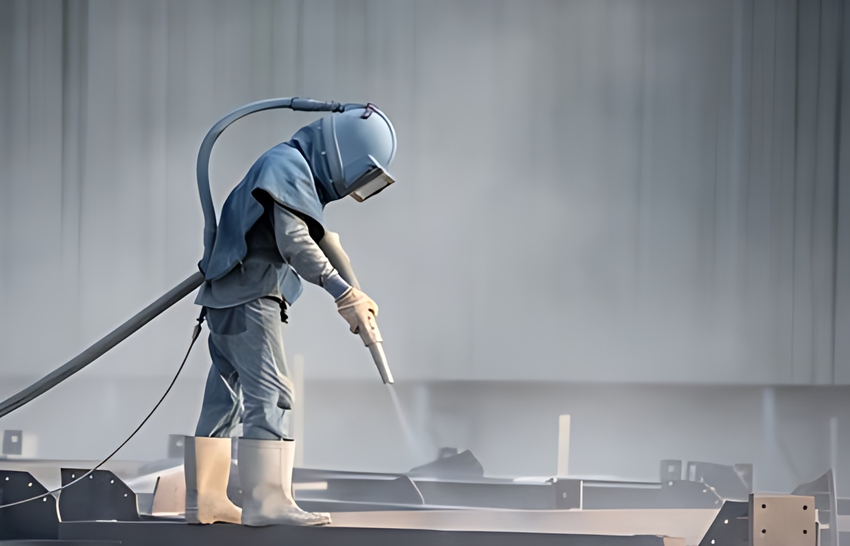Abrasive blasting, also known as sandblasting, is a method used to finish metal surface projects. It involves shooting very small pieces or particles at high speed to clean the surface and get it ready for painting or other finishing work. It depends on how the metal will be used in the end. Sandblasting is perfect for removing things like mill scale, oil, rust, and other harmful stuff on newly made steel parts. These things can harm the project.
Cleaning metal by hand takes a lot of time and is tough. On the other hand, sandblasting is quick and easy. It can be helpful for any type of project, and the material chosen for sandblasting in New Jersey affects how things will look in the end.
Here are some methods you must know about when choosing sandblasting for your next project!
Silica Sand or Silicon Dioxide-
Silica sand is regular sand that can be found anywhere. Historically, silica sand was used most frequently for sandblasting because it can effectively and safely remove surface imperfections while producing a smooth, clean appearance. However, it has been discovered that various abrasives perform equally well in a variety of metal manufacturing projects.
Soda-
Soda sandblasting is gentle on softer metals as it doesn’t chemically react or abrade aggressively like other materials. This method works well for delicate metals, providing cleansing and smoothing effects without causing harm or uneven surfaces.
Steel Grit-
Steel grit can be used for scraping as well as blasting. Steel has a quick-cutting effect that is useful in thick surface preparation before painting and is abrasive enough to remove corrosion and rust from hard metal surfaces. In heavy machinery, aviation, and the automobile industry, steel sandblasting is prevalent. Steel grit is recyclable and leaves a smooth finish.
Glass Bead-
Glass bead sandblasting gives the metal surface a distinctive matte or satin texture and is a great method for preparing surfaces for paint. It will leave a neat surface on a variety of metals, although glass beads work best on softer metals like aluminum. The beads are safe for the environment and devoid of silica.
Bristle Blasting-
Bristle blasting is used only to remove tough corrosion or burrs from abrasive surfaces. In order to remove impurities and produce a smooth surface finish, the steel bristles are organized in a brush-like pattern and rotated over the metal surface.
Advantages of sandblasting!
Sandblasting offers several benefits in various applications, some of which are illustrated below:
Simplicity-
Sandblasting is a relatively easy task. Even though a professional must complete the task, it is not a laborious or time-consuming activity. Professionals will place a tarp beneath the target surface to facilitate quick and simple cleanup. Then, they simply take out the excess material and clean the tarp after the job is finished.
Versatility-
The applications for sandblasting are numerous. It can be used to remove paint and strip pavement. Surfaces will be polished and refined while being cleaned by sandblasting. This polishing will provide a completed product with excellent aesthetics or adequately prime a surface for painting. Sandblasting can be utilized on both hard surfaces like pavement and softer surfaces like table tops, as well as on precise components like tiny gears.
Rust Removal-
Rust is a big issue for metal stuff. It’s the main reason things get damaged, as it eats away metal and can easily move to other things. If you don’t take care of it, rust can wreck things. This is bad for machines, which might not work right or become worthless if a part rusts. Sandblasting is an excellent way to get rid of rust, and it’s really important to keep metal stuff strong and in good shape.
Safety-
The method of sandblasting is non-toxic and friendly to the environment. Since natural sand is used in the process, there is no dangerous dust to breathe in. It does not employ any potentially harmful substances for humans or the environment. The substance used in sandblasting can be handled, inhaled, and disposed of without causing any harm to people or the environment.
Excellent Results-
Sandblasting is a very powerful technique. Nearly any surface can be cleaned with it, and any impurities that might harm the product or impair its look can be eliminated. A product’s functionality and durability can be increased by using sandblasting to clean it. This technique can restore surface damage caused by rust when used to remove it. Sandblasting is a very efficient method for producing a properly polished product.
Why hire a qualified and trusted sandblasting contractor in NJ?
A skilled staff is well aware of why maintaining the vital components of a facility is important for a business’s success. For residential, commercial, and industrial clients, sandblasting solutions are flexible enough to fulfill a variety of surface preparation and restoration needs. Sandblasting experts have extensive experience managing various operations, ensuring accuracy, efficiency, and outstanding results.
You can, therefore, rest assured that specialists will complete the job in accordance with your requirements and specifications while following strict safety guidelines and environmental laws.
Conclusion-
NJ-Reliable Coatings LLC stands out as an exceptional choice when seeking top-notch sandblasting services in NJ. With their proven expertise, commitment to quality, and dedication to customer satisfaction, you can trust them to deliver outstanding results for your sandblasting needs.
Choosing NJ Reliable Coatings LLC means opting for reliability, professionalism, and a partner that consistently exceeds expectations in the realm of sandblasting services.














